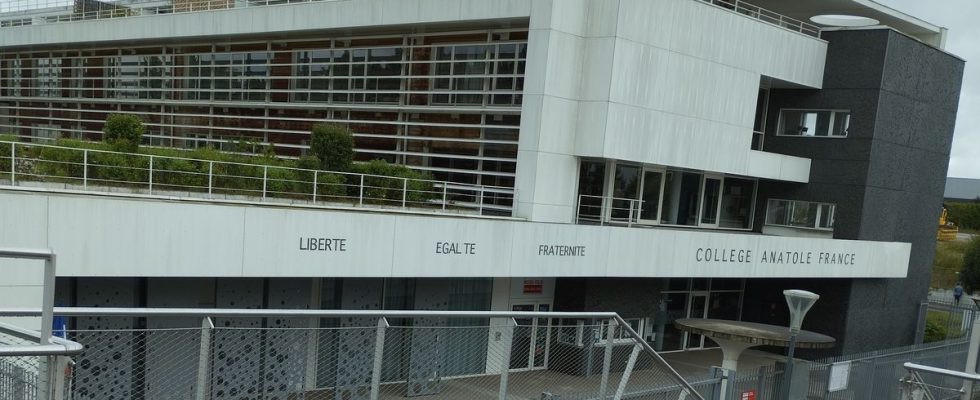It is 11 a.m. at the Anatole-France college, in the town of Les Pavillons-sous-Bois (Seine-Saint-Denis). The weather is greyish but it is an important day for the central kitchen of this establishment. She opens these doors to us to present the recipe for coleslaw, a vegetarian dish mixing carrots, tofu, white cabbage and red cabbage, with a mayonnaise to bind everything together, which will be offered as a novelty at the start of the school year to many secondary school students in the department.
After putting on a charlotte and a blouse, we are ready to discover the interior of their central kitchen which supplies 130 schools in the area. “We work on this recipe ourselves, when many central kitchens (outside Seine-Saint-Denis) use ready-made products” assures Alice Giralte, director of education and youth at the Seine-Saint-Denis Departmental Council. The objective by 2025 is to present half-board pupils with vegetarian dishes as an alternative to the usual meals of the week.
To do this, many people are involved in achieving this goal. Keyvan Mostafavi, campaign manager and representative of the Vegetable Plates association, speaks: “We work with many communities, few offer commitments like yours, a daily vegetarian meal commitment, you are at the forefront of ecological transition, public health issues. » he congratulates the people working for the community.
Here, the cooks are trained to create their own recipes, everything is set up by the college to have the best possible ingredients. For Robin Monnier, Deputy Director General of Services at the Seine-Saint-Denis Departmental Council, this is an essential aspect: “How we choose the foodstuffs, the reflection focuses on the choice of our suppliers. We went from Rungis, a dozen suppliers, to local producers and suppliers, so 27 or 28 different suppliers. We will be able to have more precise traceability work, more raw products and products from short circuits. »
Better ingredients therefore for more quality in the meals, but from a training point of view, how do we educate cooks to concoct vegetarian meals? Keyvan Mostafavi and Assiettes Végétales bring their expertise to the college: “On the training aspect of vegetarian meals, there is a strong cultural side that exists with the students but also with the kitchen teams. there is an education to be done, the challenge is to provide working-class children with fruits and vegetables, the fight is at this level. There may be kitchen attendants who are afraid to serve an unbalanced meal. »

An education to do and myths to deconstruct, this also involves the (re) discovery of new foods. “We have to teach them to cook legumes. During the training they are taught to cook lentils, red beans, coral lentils, chickpeas, there are many different ways to cook them. concludes the association representative.
Several foods that would provide the necessary intake of vitamins, minerals and fiber to allow children to grow up healthy. For Stéphane Troussel, President of the Departmental Council of Seine-Saint-Denis, it is the vegetables and their many contributions that have a high cost: “The low-income families go without vegetables, which are more expensive, and tend to reduce them or even remove them from the diet. »
The college therefore offers better food to its students, with fresh products and recipes created by trained cooks. Adopting the approach of offering vegetarian dishes is also linked to environmental issues, concludes Stéphane Troussel. “We wanted to adopt this approach as quickly as possible. An average French person produces 10 tons of Co2 per year, of these two tonnes linked to food, 60% are linked to the consumption of animal products. Reducing the share of meat is an extra effort for environmental issues. »
If the college’s goal is to have a vegetarian alternative at every meal in 2025. The goal is to do it gradually. The possibility of bringing the best products to those who need them is essential, according to Philippe Dallier, the mayor of Pavillons-sous-Bois: “Many families, for reasons of means, resort to ready-made products of questionable quality. If communities are able to provide the best quality meals in schools, this is a very important point. »
The former senator who had passed the Egalim law explains the need to evolve in the field of food. “I’m not sure that when laws are passed, parliamentarians are always aware of the difficulty of implementation. I am happy to see that here, indeed, things are progressing and that we are moving towards this quest for quality food for children and also to reduce CO2 emissions”. In this commune of 92, 30% of half-board students do not eat meat for one reason or another. there is therefore a real demand to be met, and new consumption habits to be adopted, for better student nutrition and for a “greener” world.


